


 We'll take the #40s in chronological order. Outfielder Bob Kennedy (1954), father of ex-O's catcher Terry, was the first. He was followed by second baseman Don Leppert (1955), who was one of the seventeen players who changed hands in a trade with the Yankees the previous offseason. Mel Held (1956) pitched seven innings in the majors, all in an Orioles uniform. Lefty hurler Johnny Schmitz (1956) finished his thirteen-year career in the orange and black. Shortstop Jim Brideweser (1957) wore #40 in his second stint in Baltimore. Nineteen-year-old southpaw Ron Moeller (1958) and rookie outfielder Chuck Oertel (1958) split the number one year. Spare outfielder Barry Shetrone (1959-1962) was a hometown boy who amassed only 60 games in his big league career.
We'll take the #40s in chronological order. Outfielder Bob Kennedy (1954), father of ex-O's catcher Terry, was the first. He was followed by second baseman Don Leppert (1955), who was one of the seventeen players who changed hands in a trade with the Yankees the previous offseason. Mel Held (1956) pitched seven innings in the majors, all in an Orioles uniform. Lefty hurler Johnny Schmitz (1956) finished his thirteen-year career in the orange and black. Shortstop Jim Brideweser (1957) wore #40 in his second stint in Baltimore. Nineteen-year-old southpaw Ron Moeller (1958) and rookie outfielder Chuck Oertel (1958) split the number one year. Spare outfielder Barry Shetrone (1959-1962) was a hometown boy who amassed only 60 games in his big league career.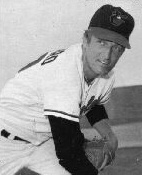
Journeyman outfielder Willie Harris (2001), known for his double-earflapped helmet, got his start in Baltimore. The signing of outfielder/designated hitter Marty Cordova (2002-2003) was a major folly; he famously missed a game after falling asleep in a tanning bed. The last few players in this list are retread catcher Keith Osik (2004); hard-throwing reliever Eddy Rodriguez (2004); Tim Byrdak (2005-2006), who had last pitched in the bigs in 2000 prior to suiting up for the O's; reliever Winston Abreu (2006); Canadian outfielder Adam Stern (2007); and power-hitting catcher J. R. House (2007), who has failed to catch on with three separate teams so far. The consistently erratic, 6'9" Daniel Cabrera (2008) discarded the #35 he'd worn for his first four seasons and chose to take the mound in #40, with no real explanation given. The change didn't produce results on the mound, and the team parted ways with Daniel the following offseason. First baseman Rhyne Hughes (2010) made a statement with four hits and two RBI in his first two major league games before running out of steam. Number forty got passed around in 2010, with infielder Scott Moore wearing it during a 41-game swing in midseason. In September, the third time proved a charm for pitcher Troy Patton (2010-2011), who had gone unused in two previous stints in #54. He finally made a single relief appearance, three years after last taking to a big league mound with the Astros.

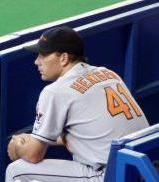
At long last, we call it quits with a few more pitchers. These include Babe Birrer (1956); Cuban-born Mike Fornieles (1956-1957); teenage rookie Jerry Walker (1958); John Pacella (1984); "Texas" Mike Smith (1989-1990), who very nearly became a teammate of "Mississippi" Mike Smith (the latter was traded to the Pirates before ever getting the callup); also-ran lefty Paul Kilgus (1991); and reliever Archie Corbin (1996). The last two #41s were erratic relievers Bob McCrory (2008, 2009), who'd worn #31 in earlier trials with the club, and Armando Gabino (2010). Bullpen coach Rick Adair lays claim to the number in 2011.

 First things first: the Orioles, as part of a league-wide tribute, retired #42 on April 15, 1997 in recognition of the 50th anniversary of
First things first: the Orioles, as part of a league-wide tribute, retired #42 on April 15, 1997 in recognition of the 50th anniversary of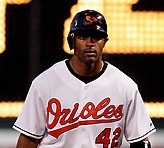 Jackie Robinson's debut with the Dodgers. It was the fifth number retired by the O's; catcher Lenny Webster (1997-1999), who had been wearing the number prior to that date, was allowed to continue in #42 until his release in 1999. Webster had a few good years splitting time with Chris Hoiles, including a career high 10 home runs and 46 RBI in 1998. In 2007, players across the league were allowed to wear #42 for one game only on Jackie Robinson Day. Many
Jackie Robinson's debut with the Dodgers. It was the fifth number retired by the O's; catcher Lenny Webster (1997-1999), who had been wearing the number prior to that date, was allowed to continue in #42 until his release in 1999. Webster had a few good years splitting time with Chris Hoiles, including a career high 10 home runs and 46 RBI in 1998. In 2007, players across the league were allowed to wear #42 for one game only on Jackie Robinson Day. Many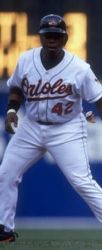 teams chose to have all players and coaches wear it, but outfielder Corey Patterson (2007) was the sole Oriole to have the honor. The tradition continued in 2008, with young outfielder Adam Jones being selected by Dave Trembley to represent the Birds. Of course, commissioner Bud Selig took a good idea and drove it into the ground in 2009 by having all uniformed personnel on all 30 teams wear #42. Oh well.
teams chose to have all players and coaches wear it, but outfielder Corey Patterson (2007) was the sole Oriole to have the honor. The tradition continued in 2008, with young outfielder Adam Jones being selected by Dave Trembley to represent the Birds. Of course, commissioner Bud Selig took a good idea and drove it into the ground in 2009 by having all uniformed personnel on all 30 teams wear #42. Oh well.
A burly ex-Yankee, Hank Bauer (1963-1968) came to Baltimore as third base coach in 1963. The following season, he supplanted Billy Hitchcock as manager, and brought a winning attitude to the talented young Birds. They sat at the top of the American League for most of the summer before fading in September, eventually finishing one game behind the White Sox and two games behind the damned Yankees. After another third-place finish in 1965, the O's put it together in 1966, taking the AL crown by nine games. Bauer's boys kept on rolling, sweeping the favored Dodgers in four straight games to bring the World Championship home to Charm City. Despite his great track record, Hank was fired when the Orioles sunk to sixth place in 1967 and were slow out of the gate again the next year. Of course, the rookie manager they replaced him with turned out to be pretty good himself. I can't recall his name...Earl somebody.
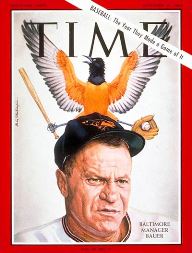
After Hank Bauer's departure, nobody in Birdland wore #42 for fifteen years; it was eventually claimed by reliever Tom Underwood (1984). Underwood was decent enough, but a couple young pitchers with much brighter futures donned the number in later years. New Yorker Pete Harnisch (1988-1989) didn't seem to round into form until switching to #17 in 1990. Rookie catcher Chris Hoiles (1990) wore #42 during a June callup, but after he went back to Rochester the Birds traded for aging designated hitter/first baseman Ron Kittle, who had sported #42 throughout his career. When Hoiles returned to Baltimore later that year, he switched to #28. Kittle stunk out loud and was not brought back. The O's got a lot of mileage out of their #1 draft pick in 1990, Stanford righthander Mike Mussina (1991). He made it to Baltimore in his second year as a pro, and won the first 4 games of his career in #42. The next 246 victories and counting (153 in orange and black) were in #35.
Two Orioles coaches have dressed in the #42 jersey: Cal Ermer (1962) and pitching coach and ex-O's pitcher Ken Rowe (1985).
Additional forty-twos include Gordie Sundin (1956), who walked the only two batters he ever faced and was stuck with an infinite ERA; outfielder Carl "Jug" Powis (1957); young catcher Frank "Noodles" Zupo (1957, 1958, 1961); reliever Rich Bordi (1986), a member of Rick Dempsey's Invisible Orioles Magic Band; outfielder Nelson Simmons (1987); pitcher Mike Griffin (1987); and designated hitter/outfielder Sherman Obando (1993, 1995).

 The best player to wear #43 for the Orioles was pitcher Curt Schilling (1988, 1989, 1990). The only problem is that he didn't put it all together until he was long gone from Baltimore. With the O's he was an immature flamethrower who didn't have much interest in the art of pitching, and it showed (1-6, 4.54 ERA). But he did meet his wife Shonda here, so...good for him, I guess.
The best player to wear #43 for the Orioles was pitcher Curt Schilling (1988, 1989, 1990). The only problem is that he didn't put it all together until he was long gone from Baltimore. With the O's he was an immature flamethrower who didn't have much interest in the art of pitching, and it showed (1-6, 4.54 ERA). But he did meet his wife Shonda here, so...good for him, I guess.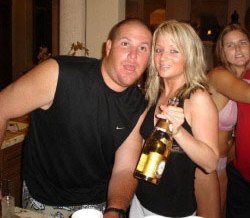 Speaking of talented pitchers who could have used an attitude adjustment, you might have heard of Sidney Ponson (1998-2003, 2004-2005). The stocky Aruban gave the Birds plenty of hope in his first three seasons, winning 29 games and going the distance 12 times. All along, though, there were questions about his attitude and conditioning. Sir Sidney finally had a breakout year in 2003, starting 14-6 before the O's swapped him to the Giants for three young pitchers (none of whom worked out, naturally). Team brass figured they were getting the best of both worlds when they convinced Ponson to re-sign that winter for 3 years, $22.5 million. Instead, their new investment showed up to camp overweight (even for him) and got off to a sparkling 3-12 start, losing NINE straight games. Though he rebounded with an 8-3 second half, the tone had been set. In 2005 Sidney would spend 11 days in an Aruban jail for assaulting a judge and accumulate two DUIs. This behavior, combined with the continued putrescence of his on-field work, left the Orioles with no choice but to terminate his contract. They cited a morals clause. Though a grievance was filed, he has yet to see a cent of what was "owed" him. As you can tell, he is sorely missed.
Speaking of talented pitchers who could have used an attitude adjustment, you might have heard of Sidney Ponson (1998-2003, 2004-2005). The stocky Aruban gave the Birds plenty of hope in his first three seasons, winning 29 games and going the distance 12 times. All along, though, there were questions about his attitude and conditioning. Sir Sidney finally had a breakout year in 2003, starting 14-6 before the O's swapped him to the Giants for three young pitchers (none of whom worked out, naturally). Team brass figured they were getting the best of both worlds when they convinced Ponson to re-sign that winter for 3 years, $22.5 million. Instead, their new investment showed up to camp overweight (even for him) and got off to a sparkling 3-12 start, losing NINE straight games. Though he rebounded with an 8-3 second half, the tone had been set. In 2005 Sidney would spend 11 days in an Aruban jail for assaulting a judge and accumulate two DUIs. This behavior, combined with the continued putrescence of his on-field work, left the Orioles with no choice but to terminate his contract. They cited a morals clause. Though a grievance was filed, he has yet to see a cent of what was "owed" him. As you can tell, he is sorely missed.Among the position players are two-time Oriole outfielder Curt Motton (1973); shortstop/second baseman and Baltimore native Tim Nordbrook (1974-1975); infielder Steve Scarsone (1992); outfielder Tony Tarasco (1997), who switched from #3 late in the season when Harold Baines was reacquired; and corner infielder Scott Moore (2007), acquired in the Steve Trachsel deal. Though Moore switched to #9 to begin 2008, it's interesting to note that when he was sent to AAA Norfolk early that season, he was replaced by pitcher Jim Johnson (2008-2010), who then donned #43. Johnson had stumbled in previous cups of coffee as a starter, but has proven to be a surprise asset as a late-inning reliever. He put up a tiny 2.23 ERA in his rookie season and was under 3.00 at the end of August 2009 before faltering in the closer's role. An elbow injury truncated his 2010 season.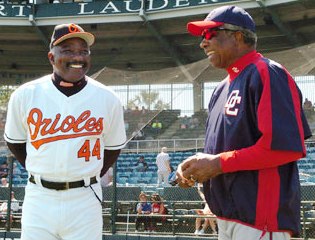

 Number 44 will forever be linked to bullpen coach and former catcher Elrod Hendricks (1978-2005). "Ellie" spent an amazing thirty-seven seasons in an Orioles uniform altogether, and was a goodwill ambassador and a vital link between the team and the community. Generations of O's fans were warmed by his trademark smile. During the offseason, Elrod could be found doing anything from playing Santa Claus for area children to hosting the team's Winter Cruise. In 2001, he was the first member of the Orioles Hall of Fame to be inducted while still in an active capacity with the club. After Hendricks died of a heart attack in December 2005, the team honored him by wearing his #44 on the left sleeve of their jerseys throughout the 2006 season. It also appears that they are not issuing the number for the foreseeable future. As an interesting side note, a 37-year-old Hendricks made his pitching debut in 1978, tossing two and one-third scoreless innings of relief.
Number 44 will forever be linked to bullpen coach and former catcher Elrod Hendricks (1978-2005). "Ellie" spent an amazing thirty-seven seasons in an Orioles uniform altogether, and was a goodwill ambassador and a vital link between the team and the community. Generations of O's fans were warmed by his trademark smile. During the offseason, Elrod could be found doing anything from playing Santa Claus for area children to hosting the team's Winter Cruise. In 2001, he was the first member of the Orioles Hall of Fame to be inducted while still in an active capacity with the club. After Hendricks died of a heart attack in December 2005, the team honored him by wearing his #44 on the left sleeve of their jerseys throughout the 2006 season. It also appears that they are not issuing the number for the foreseeable future. As an interesting side note, a 37-year-old Hendricks made his pitching debut in 1978, tossing two and one-third scoreless innings of relief.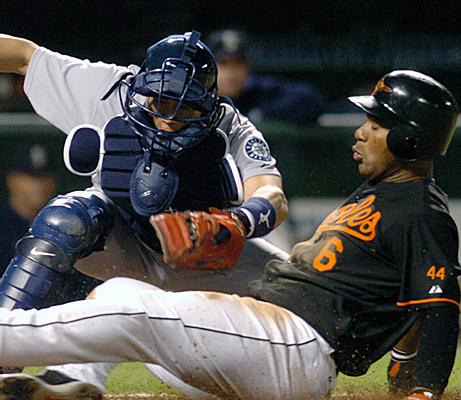

 Lefthanded pitcher Erik Bedard (2004-2007) became the best player to wear #45 for the Orioles in a short amount of time. After debuting in 2002 in #57, the young Canadian gave fans a glimmer of hope by throwing 137 league-average innings in 2004 with 121 strikeouts. He caught fire along with the rest of the team in early 2005, starting out 5-1 with a 1.89 ERA before injuries dragged him back down to Earth. He seems to get better every year, as
Lefthanded pitcher Erik Bedard (2004-2007) became the best player to wear #45 for the Orioles in a short amount of time. After debuting in 2002 in #57, the young Canadian gave fans a glimmer of hope by throwing 137 league-average innings in 2004 with 121 strikeouts. He caught fire along with the rest of the team in early 2005, starting out 5-1 with a 1.89 ERA before injuries dragged him back down to Earth. He seems to get better every year, as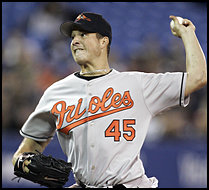 he won 28 games and losing just 16 for some pretty subpar teams in 2006-2007. In 2007 he broke Mike Mussina's Orioles record for strikeouts in a season, whiffing 221 batters in just 182 innings. Of course, Bedard's performance made him just as valuable on the trade market as he was in Baltimore, and he was dealt to Seattle for five young players to help bolster the O's rebuilding effort. His uni number was quickly taken by hard-throwing reliever Dennis Sarfate (2008-2009).
he won 28 games and losing just 16 for some pretty subpar teams in 2006-2007. In 2007 he broke Mike Mussina's Orioles record for strikeouts in a season, whiffing 221 batters in just 182 innings. Of course, Bedard's performance made him just as valuable on the trade market as he was in Baltimore, and he was dealt to Seattle for five young players to help bolster the O's rebuilding effort. His uni number was quickly taken by hard-throwing reliever Dennis Sarfate (2008-2009).
 Lefthanded pitcher Mike Flanagan (1975-1987, 1991-1992) appears a lot in the Orioles' record book. Only two pitchers have thrown
Lefthanded pitcher Mike Flanagan (1975-1987, 1991-1992) appears a lot in the Orioles' record book. Only two pitchers have thrown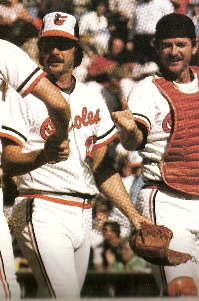 more innings in an O's uniform (Jim Palmer and Mike Mussina). He also ranks fifth in wins, with 141; he is fourth in strikeouts and complete games and seventh in shutouts. His greatest season was in 1979, when he won the Cy Young Award for the AL Champion Orioles (23-9, 3.08 ERA). As the team started to bottom out in the mid-1980s, Flanny declined as well. He was dealt to the Blue Jays in late 1987 for pitchers Oswald Peraza and Jose Mesa. But the 39-year-old Flanagan came back to the nest in 1991, and was reborn as a relief pitcher (2.38 ERA). He pitched a strong seventh inning in relief of Bob Milacki on July 13, 1991 in Oakland; eventually, it would be the fifth no-hitter in Orioles' history. Fittingly, Flanagan was also the last O's pitcher to appear in a game at Memorial Stadium, mopping up a 7-1 loss to Detroit in October. After a poor 1992 season, he hung up his spikes. Mike has remained in town through his post-playing years, serving as a TV commentator for O's games, as pitching coach (1995, 1998), and most recently, as a front office executive.
more innings in an O's uniform (Jim Palmer and Mike Mussina). He also ranks fifth in wins, with 141; he is fourth in strikeouts and complete games and seventh in shutouts. His greatest season was in 1979, when he won the Cy Young Award for the AL Champion Orioles (23-9, 3.08 ERA). As the team started to bottom out in the mid-1980s, Flanny declined as well. He was dealt to the Blue Jays in late 1987 for pitchers Oswald Peraza and Jose Mesa. But the 39-year-old Flanagan came back to the nest in 1991, and was reborn as a relief pitcher (2.38 ERA). He pitched a strong seventh inning in relief of Bob Milacki on July 13, 1991 in Oakland; eventually, it would be the fifth no-hitter in Orioles' history. Fittingly, Flanagan was also the last O's pitcher to appear in a game at Memorial Stadium, mopping up a 7-1 loss to Detroit in October. After a poor 1992 season, he hung up his spikes. Mike has remained in town through his post-playing years, serving as a TV commentator for O's games, as pitching coach (1995, 1998), and most recently, as a front office executive.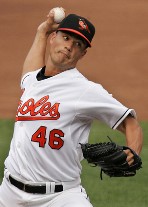 A former #1 draft pick of the Indians, righthander Jeremy Guthrie (2007-present) seemed to be mishandled by the Cleveland organization. Caught in a numbers crunch, he was snatched up by the Orioles in January 2007 at the urging of future manager Dave Trembley. Guthrie was one of the few pleasant surprises of recent years for the Birds. After starting out in the bullpen (and earning his first major league win), he was asked to step into an injury-wracked starting rotation. Once he was slotted in Guthrie never looked back, ranking among the league leaders in ERA for much of the season before wearing down late. Overall, he was 7-5 with a 3.70 ERA, and could have easily won at least fifteen games if not for poor run support and a shaky bullpen. He led the staff in wins (10) and ERA (3.63) in 2008 before having an off year in 2009. Even so, he reached the 200-inning milestone and rebounded in 2010 with 11 wins, a 3.83 ERA, and career highs of 209.1 innings and a 1.16 WHIP.
A former #1 draft pick of the Indians, righthander Jeremy Guthrie (2007-present) seemed to be mishandled by the Cleveland organization. Caught in a numbers crunch, he was snatched up by the Orioles in January 2007 at the urging of future manager Dave Trembley. Guthrie was one of the few pleasant surprises of recent years for the Birds. After starting out in the bullpen (and earning his first major league win), he was asked to step into an injury-wracked starting rotation. Once he was slotted in Guthrie never looked back, ranking among the league leaders in ERA for much of the season before wearing down late. Overall, he was 7-5 with a 3.70 ERA, and could have easily won at least fifteen games if not for poor run support and a shaky bullpen. He led the staff in wins (10) and ERA (3.63) in 2008 before having an off year in 2009. Even so, he reached the 200-inning milestone and rebounded in 2010 with 11 wins, a 3.83 ERA, and career highs of 209.1 innings and a 1.16 WHIP.
Wrapping up the forty-sixes, you'll find pitcher Don Ferrarese (1955-1956); veteran reliever Ernie Johnson (1959); outfielder Butch Davis (1989); relievers Jay Aldrich (1990) and Dorn Taylor (1990); second-generation Orioles pitcher John P. O'Donoghue (1993); reliever Jimmy Myers (1996); and former Braves closer Kerry Ligtenberg (2003), who pitched well as an eighth-inning guy in Baltimore.

 Chances are that you've heard some of the age-related jabs aimed at lefty relief specialist Jesse Orosco (1995-1999). After all,
Chances are that you've heard some of the age-related jabs aimed at lefty relief specialist Jesse Orosco (1995-1999). After all, 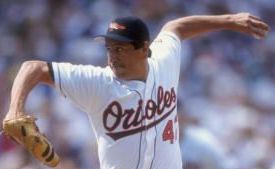 he was once traded for Jerry Koosman, who pitched for the 1969 Amazin' Mets. But Orosco's remarkable longevity was no joke; he pitched for nine teams in a 24-year career that spanned four decades (1979-2003), retiring at age 46. Late in his career, he had several very good seasons in an Orioles uniform. He posted ERAs of 3.40 or lower for four straight years before faltering in his final campaign in Baltimore. "The old Indian", as former teammate Alan Mills lovingly called him, also averaged about one strikeout per inning in the orange and black, proving that he could still baffle left-handed hitters. Before the 2000 season he was traded to the Mets for another lefty, Chuck McElroy (2000-2001); McElroy took the #47 jersey vacated by Orosco.
he was once traded for Jerry Koosman, who pitched for the 1969 Amazin' Mets. But Orosco's remarkable longevity was no joke; he pitched for nine teams in a 24-year career that spanned four decades (1979-2003), retiring at age 46. Late in his career, he had several very good seasons in an Orioles uniform. He posted ERAs of 3.40 or lower for four straight years before faltering in his final campaign in Baltimore. "The old Indian", as former teammate Alan Mills lovingly called him, also averaged about one strikeout per inning in the orange and black, proving that he could still baffle left-handed hitters. Before the 2000 season he was traded to the Mets for another lefty, Chuck McElroy (2000-2001); McElroy took the #47 jersey vacated by Orosco.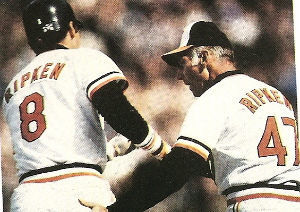 For many years, this jersey number was identified with Orioles lifer Cal Ripken, Sr. (1976-1985). "Senior" was the third base coach for eleven-plus years before getting the chance to manage the team when Earl Weaver retired a second time in 1987. After his unfortunate firing at the beginning of the 1988 season, Cal eventually returned in a coaching capacity for four more years. He wore #47 for his first decade in Baltimore before switching to #7. Cal Ripken, Jr. tells a story in his autobiography about his rookie year, when he made the mistake of referring to Cal, Sr. as "Dad". After taking a heavy dose of teasing from his teammates, Junior was sure to refer to his father as "Coach" or "Number 47" thereafter!
For many years, this jersey number was identified with Orioles lifer Cal Ripken, Sr. (1976-1985). "Senior" was the third base coach for eleven-plus years before getting the chance to manage the team when Earl Weaver retired a second time in 1987. After his unfortunate firing at the beginning of the 1988 season, Cal eventually returned in a coaching capacity for four more years. He wore #47 for his first decade in Baltimore before switching to #7. Cal Ripken, Jr. tells a story in his autobiography about his rookie year, when he made the mistake of referring to Cal, Sr. as "Dad". After taking a heavy dose of teasing from his teammates, Junior was sure to refer to his father as "Coach" or "Number 47" thereafter!
 Right off the bat, I'll tell you that #48 isn't very exciting. Starting pitcher "Fat Jack" Fisher (1959-1961) is primarily known for surrendering historic home runs. In 1960, Ted Williams hit his 521st and final home run in the last at bat of his career off of Fisher. The following year, Roger Maris of the Yankees tied Babe Ruth by hitting his 60th round tripper of the season off of the Orioles righthander. Fisher, a native of Frostburg, had his finest year in 1960. The 22-year-old went 12-11, his only winning season, and tossed 29 and two-thirds consecutive scoreless innings in August and September to finish with a 3.41 ERA.
Right off the bat, I'll tell you that #48 isn't very exciting. Starting pitcher "Fat Jack" Fisher (1959-1961) is primarily known for surrendering historic home runs. In 1960, Ted Williams hit his 521st and final home run in the last at bat of his career off of Fisher. The following year, Roger Maris of the Yankees tied Babe Ruth by hitting his 60th round tripper of the season off of the Orioles righthander. Fisher, a native of Frostburg, had his finest year in 1960. The 22-year-old went 12-11, his only winning season, and tossed 29 and two-thirds consecutive scoreless innings in August and September to finish with a 3.41 ERA.
 As you might expect with a higher number, #49 has been worn by several Orioles relief pitchers. Most of them have actually been valuable contributors. Super-sized righty Tim Stoddard (1978-1983) was the winning pitcher in Game Four of the 1979 World Series, driving in the eventual winning run with an eighth inning single in his first major league at-bat. He also saved a career-high 26 games for the Birds in 1980 to lead the team. Stoddard was followed by former Dodgers playoff goat Tom Niedenfuer (1987-1988), who topped the worst O's team of all time with 18 saves in 1988. Submariner Todd Frohwirth (1991-1993) won 17 games and saved 10 more in three years in Charm City, and his 1.87 ERA in 1991 was a team low.
As you might expect with a higher number, #49 has been worn by several Orioles relief pitchers. Most of them have actually been valuable contributors. Super-sized righty Tim Stoddard (1978-1983) was the winning pitcher in Game Four of the 1979 World Series, driving in the eventual winning run with an eighth inning single in his first major league at-bat. He also saved a career-high 26 games for the Birds in 1980 to lead the team. Stoddard was followed by former Dodgers playoff goat Tom Niedenfuer (1987-1988), who topped the worst O's team of all time with 18 saves in 1988. Submariner Todd Frohwirth (1991-1993) won 17 games and saved 10 more in three years in Charm City, and his 1.87 ERA in 1991 was a team low.
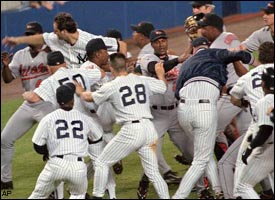
Mercurial righthander Armando Benitez (1994-1998) provided several highs and lows during his five seasons in orange and black. He did his best work in Baltimore as a setup man for Randy Myers, winning two games in the 1996 ALDS and peaking with 106 strikeouts in 73 and one-third innings in 1997. However, he came up short at the most inopportune times, allowing six runs in five and one-third innings in the Orioles' back-to-back ALCS appearances. He was instrumental in three of the team's four losses in the heartbreaking 1997 ALCS loss to Cleveland. Benitez also had a penchant for losing his cool, most famously touching off a fierce brawl with the Yankees by plunking Tino Martinez in May 1998. Sure, we all want to haul off and take a swing at a Yankee now and then, but that doesn't mean it's a good idea.
A more heartwarming story is that of bespectacled pitcher Travis Driskill (2002-2003). The minor league veteran made his big league debut with the O's at the age of thirty and made a splash by starting his career with five straight wins before settling back down to the mean. After making 20 appearances out of the Birds' bullpen in 2003, he has had a few cups of coffee in the National League.
In 1965, a rookie shortstop named Mark Belanger (1965) became the first Oriole to ever wear #49. He stuck around the following year and chose the more glamorous #7; no player would wear Mark's discarded uniform number until Stoddard in 1978.
Who else has worn forty-nine, you ask? Well, there's outfielder Stan Jefferson (1989, 1990), who had some surprising clutch hits in limited action in 1989; wandering outfielder Brad Komminsk (1990); post-Tommy John surgery pitcher Doug Linton (1999); pitching coach Sammy Ellis (2000); relievers John Bale (2001) and Darwin Cubillan (2004); and young pitchers John Maine (2004), Hayden Penn (2005-2006), and Jason Berken (2009-present), who endured a personal nine-game losing streak as a rookie and seemed to find his calling as a long reliever before an injury cut short his 2010 campaign.